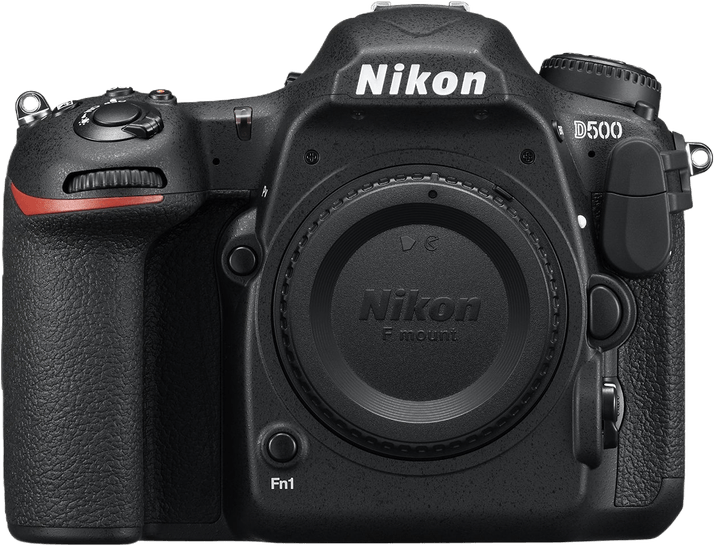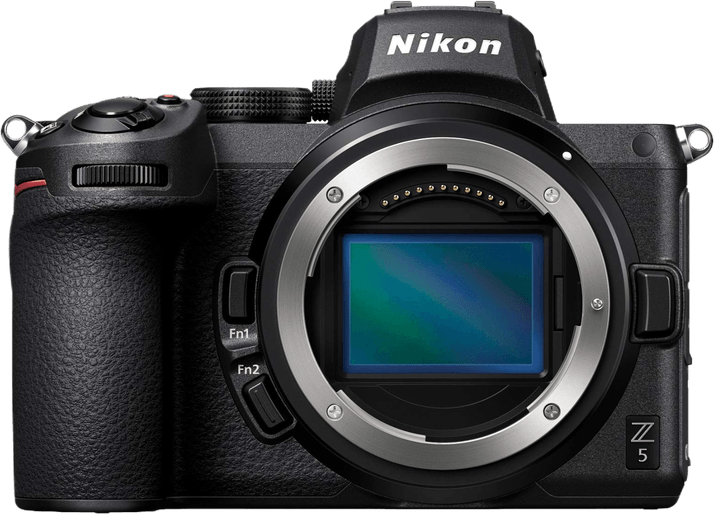Nikon D500 vs Z5 Comparison
Nikon D500

Nikon Z5

The Nikon Z5 emerges as the winner with a score of 78/100, compared to the Nikon D500‘s score of 75/100. Both cameras share similarities in their specifications, such as being released by the same manufacturer, Nikon, and having a similar launch price range.
The Nikon Z5 outperforms the D500 with its lighter weight of 675g (1.49lbs) and smaller dimensions of 134 x 100.5 x 69.5mm. Additionally, the Z5 is a more recent model, released in 2020, and benefits from being a mirrorless camera, which provides a more compact and advanced design.
On the other hand, the Nikon D500, released in 2016, is a DSLR camera with a larger size of 147 x 115 x 81mm and heavier weight of 860g (1.90lbs). Despite these factors, the D500 still has a respectable score and remains a viable option for photographers.
Considering the specifications, the Nikon Z5 is the superior choice due to its lighter weight, smaller size, and mirrorless technology. However, the Nikon D500 remains a good option for those who prefer DSLRs.
Nikon D500 vs Z5 Overview and Optics
The Nikon Z5 emerges as the winner in optics with a score of 81/100, compared to the Nikon D500’s score of 69/100. Both cameras share common features, such as a CMOS sensor, but they differ in other key areas, which sets them apart.
Both cameras have a CMOS sensor type, but the Nikon Z5 boasts a full-frame sensor, while the Nikon D500 has an APS-C sensor. The larger sensor size in the Nikon Z5 gives it an advantage in low light performance, providing better image quality. Additionally, the Nikon Z5 has a higher DXOMARK score for the sensor at 97, compared to the Nikon D500’s score of 84. This difference further highlights the superior image quality of the Nikon Z5.
The Nikon Z5 also has a higher megapixel count at 24, compared to the Nikon D500’s 20.9 megapixels, allowing for more detailed images. Furthermore, the Nikon Z5 features an Expeed 6 processor, while the Nikon D500 has an Expeed 5 processor. The updated processor in the Nikon Z5 contributes to its better overall performance. The Nikon Z5 also has image stabilization, which the Nikon D500 lacks, ensuring steadier shots and improved image quality.
However, the Nikon D500 does have a faster shooting speed of 10 frames per second, compared to the Nikon Z5’s 4.5 frames per second. This advantage makes the Nikon D500 more suitable for action photography or capturing fast-moving subjects.
Taking all these factors into account, the Nikon Z5 is the better camera in terms of optics, with advantages such as a larger sensor size, higher DXOMARK score, and image stabilization. The Nikon D500, however, may be preferable for those who require a faster shooting speed.
Nikon D500 vs Z5 Video Performance
The Nikon Z5 outperforms the Nikon D500 in video capabilities, with a video score of 83/100 compared to the D500’s 70/100. Both cameras share some common video specifications, including a maximum video resolution of 4K and dimensions of 3840 x 2160. Additionally, both cameras come with built-in time-lapse functionality.
The Nikon Z5’s superiority in video performance is primarily due to its higher maximum video frame rate of 60fps, which is double the D500’s 30fps. This higher frame rate allows the Z5 to capture smoother and more detailed video, particularly in fast-moving scenes or when recording action sequences.
The Nikon D500 does not offer any distinct advantages in video capabilities over the Z5. Its lower video score is a result of its inferior maximum video frame rate. However, it is worth noting that the D500 still provides high-quality 4K video and built-in time-lapse functionality, making it a capable camera for video enthusiasts.
When comparing the video capabilities of the Nikon D500 and the Nikon Z5, it is clear that the Z5 is the better choice for those prioritizing video performance. Its higher video score, primarily due to the 60fps maximum frame rate, makes it a more versatile and powerful camera for capturing high-quality video. While the D500 remains a competent option for video enthusiasts, the Z5’s superior video capabilities make it the clear winner in this comparison.
Nikon D500 vs Z5 Features and Benefits
The Nikon D500 emerges as the winner in the features comparison with a score of 87/100, while the Nikon Z5 scores 72/100. Both cameras share several specifications, making them quite similar in certain aspects. They have a 3.2-inch screen, touchscreen capabilities, flip screens, GPS, WIFI, and Bluetooth connectivity.
The Nikon D500 has a higher screen resolution of 2,359,000 dots, providing better image quality and a sharper display. This higher resolution allows photographers to better review and edit their images on the camera itself. The Nikon D500’s superior feature score also indicates that it has more advanced features overall, which can benefit users in various shooting situations.
On the other hand, the Nikon Z5, despite its lower feature score, still offers a decent set of specifications. Its screen resolution of 1,040,000 dots is lower than the D500’s, but it is still sufficient for most photography needs. The Z5’s lower score does not necessarily mean it is a poor choice for photographers; it simply means that it may not have as many advanced features as the D500.
In comparing the two cameras, the Nikon D500 stands out as the better option due to its higher feature score and screen resolution, which contribute to its overall performance. The Nikon Z5, while not as advanced, still provides a solid set of specifications suitable for various photography situations. Ultimately, the choice between the two cameras will depend on the individual photographer’s needs and preferences.
Nikon D500 vs Z5 Storage and Battery
The Nikon D500 surpasses the Nikon Z5 in storage and battery with a score of 79/100, while the Z5 scores 73/100. Both cameras have two memory card slots and accept SD, SDHC, and SDXC cards. However, the D500 also supports UHS-II compatible and XQD cards, providing more flexibility in storage options.
The D500 has a longer battery life, with 1240 shots per charge compared to the Z5’s 470 shots. They use different battery types: the D500 uses the EN-EL15, while the Z5 uses the EN-EL15c. The Z5 compensates for its shorter battery life with USB charging capabilities, which the D500 lacks.
To sum up, the Nikon D500 wins in storage and battery due to its compatibility with additional memory cards and longer battery life. The Nikon Z5, while having a shorter battery life, offers the convenience of USB charging.
Nikon D500 vs Z5 – Our Verdict
Are you still undecided about which camera is right for you? Have a look at these popular comparisons that feature the Nikon D500 or the Nikon Z5:

